Are you a Quiet Speculation member?
If not, now is a perfect time to join up! Our powerful tools, breaking-news analysis, and exclusive Discord channel will make sure you stay up to date and ahead of the curve.
Another week of data, another update to the Ikoria metagame. The trends had been moving towards companion stabilizing in Modern. Last week, the individual companion cards seemed volatile in terms of usage, but the mechanic itself appeared to have achieved saturation. We observed some signs suggesting that companions might be been fading in Modern, which would award success to targeted solutions---by which I mean just banning Lurrus and Yorion.

This week was the make-or-break week for companion's future. In the last banning announcement, Wizards made it clear they were watching trends in the data. Companion was having an unprecedented cross-format impact on Magic and all options were on the table, including a complete rules reworking. The obvious implication was that Wizards saw the same volatility I did, though more completely since their data is better, and were hoping to avoid taking drastic action. This week's data needs to show a reduction in companion saturation for there to be hope for an easy solution.
Week 5: 5/17-5/23
The first thing to note about last week is the population. I only recorded 147 decks in week 5, down from 167 in week 4. I don't know of any outside factors to explain this drop.
| Deck Name | Total # | Total % |
|---|---|---|
| Prowess | 27 | 18.37 |
| Other | 17 | 11.56 |
| GBx Midrange | 16 | 10.88 |
| Eldrazi Tron | 10 | 6.80 |
| Burn | 8 | 5.44 |
| Toolbox | 8 | 5.44 |
| UGx Shift | 7 | 4.76 |
| Ponza | 7 | 4.76 |
| Gx Tron | 7 | 4.76 |
| UW Control | 6 | 4.08 |
| Niv to Light | 6 | 4.08 |
| Bogles | 6 | 4.08 |
| Amulet Titan | 6 | 4.08 |
| Ad Nauseam | 4 | 2.72 |
| UGx Reclamation | 3 | 2.04 |
| Jund Shadow | 3 | 2.04 |
| As Foretold | 3 | 2.04 |
| Hardened Scales | 3 | 2.04 |
The other noteworthy development is that Eldrazi Tron has spiked. And massively. In week 4 it had a 4.2% metagame share, but jumped 6.6% week 5. I suspect that's linked to Prowess's continuous sitting on top of the metagame. Chalice of the Void is very strong in that matchup, and it's reasonable to think that E-Tron is preying on Prowess.
A Caveat
Prowess has a very high metagame share this week. Astute readers will note its rise both in absolute and relative numbers from the previous week; 26 decks and 15.6% to 27 and 18.4% respectively. The increase suggests that it is starting to dominate, and may be a uniquely dangerous deck in the current metagame; Prowess gets more utility from Lurrus of the Dream Den returning Mishra's Bauble than any other deck. However, the numbers are deceptive: Prowess jumped 8% in week 4, from 7.6% to 15.6%. The 2.8% jump this week is small potatoes in comparison and doesn't necessarily indicate much.
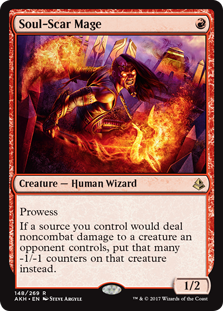 Secondly, the category is somewhat deceptive. The Prowess deck is showing considerable variation, some of which are close to entirely different decks. I've been categorizing decks based on their strategic characteristics and not stressing deck composition variance as long as decks share a recognizable gameplan. This is why Jund and Rock are lumped together as GBx Midrange while Temur Urza and Temur Reclamation are separated. The Prowess decks had been mono-red and distinguished from Burn by Soul-Scar Mage, and I've kept that definition going. The end of week 4 saw divergence as some Prowess decks started running black for discard spells. This week, there was a more even mix of BR and Mono Red, but they're still too strategically similar to separate.
Secondly, the category is somewhat deceptive. The Prowess deck is showing considerable variation, some of which are close to entirely different decks. I've been categorizing decks based on their strategic characteristics and not stressing deck composition variance as long as decks share a recognizable gameplan. This is why Jund and Rock are lumped together as GBx Midrange while Temur Urza and Temur Reclamation are separated. The Prowess decks had been mono-red and distinguished from Burn by Soul-Scar Mage, and I've kept that definition going. The end of week 4 saw divergence as some Prowess decks started running black for discard spells. This week, there was a more even mix of BR and Mono Red, but they're still too strategically similar to separate.
However, a new Jund Prowess deck has started showing up. It is more midrange than aggro, and could be a new deck. The distinction isn't quite clear enough to actually make that call, but it's getting close. Depending on how things shake out I may need to separate it from the other Prowess decks in future updates. Thus, that Prowess category isn't as monolithic or dominant as it appears.
Companion Stats
And now the big one. Companion had been stable between Weeks 3 and 4. The drop in population Week 5 appears to have affected companion saturation levels.
| Companion | Total # | Total Metagame % |
|---|---|---|
| Lurrus | 73 | 49.66 |
| Yorion | 20 | 13.60 |
| Jegantha | 8 | 5.44 |
| Obosh | 7 | 4.76 |
| Kaheera | 2 | 1.36 |
| Zirda | 2 | 1.36 |
Lurrus is trending back up. However, that is as much a function of Prowess being up as anything else. Companion has overall increased to 76% of the metagame, though again this could be an outlier effect from a smaller sample size. Still, it shows that the metagame is adapting to companion not by answering them and keeping them in check but by adopting them. I think the only discussion about them happening at Wizards now is how severe the solution needs to be.
What's the Problem?
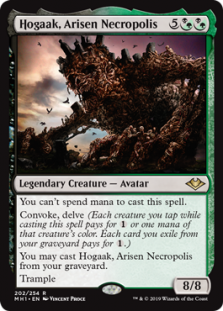 The numbers are fairly clear. There remains not only deck diversity but strategic diversity. Unlike in previous banning situations, I cannot easily point to a clear problem. One deck is not utterly dominating events, winning too much, and/or winning too quickly as Hogaak, Arisen Necropolis did. And archetypes aren't homogenizing in the way inspired by Oko, Thief of Crowns.
The numbers are fairly clear. There remains not only deck diversity but strategic diversity. Unlike in previous banning situations, I cannot easily point to a clear problem. One deck is not utterly dominating events, winning too much, and/or winning too quickly as Hogaak, Arisen Necropolis did. And archetypes aren't homogenizing in the way inspired by Oko, Thief of Crowns.
Oko rewarded and in some ways required players to run a common core of artifacts to get the most value from him, which gradually pushed all interactive decks into a samey, artifact-heavy midrange soup even before they'd leaned combo or aggro. Lurrus decks running Bauble is not the same thing, so long as the rest of the deck is strategically different.
The problem is simple saturation. Companions are everywhere, and players are getting tired of it. The closest analogue to companions is Once Upon a Time. The effect proved too good, but the final straw was universality. Once colorless Eldrazi Tron started adopting Once, the trigger got pulled. We're getting to that point with companions. They're hanging around 70% of the metagame.
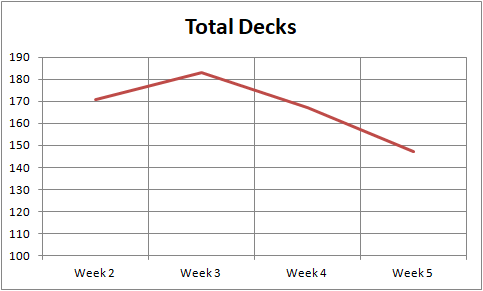
This is the chart for total decks in my sample each week. I'm not including the first week because it was shorter and the population was necessarily smaller. There have been three Premier events and four Preliminaries each week, and each Premier reports exactly 32 decks. Thus, the variation in population is directly down to the preliminary attendance. Prelims report every deck that goes 3-2 or better, and so the more in the initial tournament, the more decks should hit that mark. And over the past two weeks, the population in my samples has fallen. This suggests that overall Modern attendance has fallen, and Modern has been the most popular format until recently (looking at MTGTop8's format population data). It's reasonable to conclude that online tournament attendance is overall down as a result.
Accounting for Data Sources
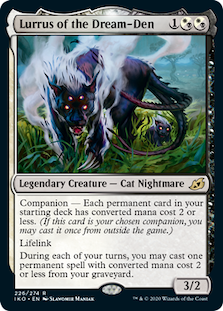 It's possible, too, that my data is the problem. Wizards is pushing Arena like crazy, which may also be drawing away players from MTGO and Modern. However, given the wider community reaction to companions, I think that's unlikely to be the cause of the falloff. There's a sense of weariness and ennui everywhere. Players have soured on constructed Magic because it has become unfun.
It's possible, too, that my data is the problem. Wizards is pushing Arena like crazy, which may also be drawing away players from MTGO and Modern. However, given the wider community reaction to companions, I think that's unlikely to be the cause of the falloff. There's a sense of weariness and ennui everywhere. Players have soured on constructed Magic because it has become unfun.
Fun is admittedly very subjective, and the only way to quantify this is with starting tournament population data that I don't have. However, given that most larger voices are saying the same thing, and even Mark Rosewater appears to have soured on companions, I think there's clear evidence that Modern's players and developers alike are not feeling the new mechanic.
Given that Commander is the most popular form of Magic and companions are fairly obviously bringing commanders to constructed, how did this happen? I chalk it up to the difference between consistency and certainty.
Consistency
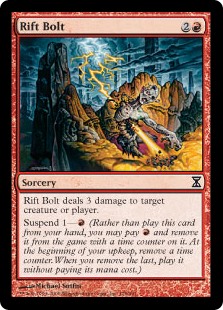 For Magic purposes, consistency this refers to a deck's ability to play out its gameplan reliably. Burn is a very consistent deck because it has many cards that do similar things. It can't play the exact same way every game, but it is able to play one out that is very similar, recognizable, or predictable. Lightning Bolt and Rift Bolt are very different cards, but do close enough to the same job in context that they let Burn players effectively play more than four copies of a card. This gives their gameplan far more consistency than something like the singleton-filled Niv to Light.
For Magic purposes, consistency this refers to a deck's ability to play out its gameplan reliably. Burn is a very consistent deck because it has many cards that do similar things. It can't play the exact same way every game, but it is able to play one out that is very similar, recognizable, or predictable. Lightning Bolt and Rift Bolt are very different cards, but do close enough to the same job in context that they let Burn players effectively play more than four copies of a card. This gives their gameplan far more consistency than something like the singleton-filled Niv to Light.
Certainty
Dictionary.com defines certainty as "an assured fact." In other words, if something is certain, it will happen. Few things are ever truly certain in constructed Magic. The best players loses to newbs, Ad Nauseam sometimes beats Infect, and variance plays a huge role. There is no  guarantee of seeing any four-of in a deck in a given game. It may never be drawn, and even if tutoring is available, it may be incorrect to choose that card. Thus, certainty has never had a place in constructed, only consistency.
guarantee of seeing any four-of in a deck in a given game. It may never be drawn, and even if tutoring is available, it may be incorrect to choose that card. Thus, certainty has never had a place in constructed, only consistency.
At least, that was true until the companions came along. There is certainty that they will appear, since they must be revealed at the start of the game. Should the game make it to the point they could be played, there is certainty that they will at some point. And that threshold (reaching a certain turn) is extremely low in a turn four format; far easier to meet than that of drawing a four-of and having a good reason to cast it. After all, companions are frequently the best option on-hand for players who are ready to cast them. This is a very Commander mechanic, and the community seems to agree that it is unwelcome in constructed.
The Commander Problem
 This makes perfect sense if the nature of Commander is considered (and makes me think that Wizards doesn't get why Commander is popular). There is no consistency in Commander. The deck is 100 cards, and every nonbasic land is a singleton. Games can be, and usually are, wildly different from each other for that reason. This is a large part of the appeal. However, this also means that the risk of non-games are higher. Low consistency means high variance and high variance means more risk of non-games. Commander is, more than any other format, about fun, and so there are allowances made (e.g. free mulligans).
This makes perfect sense if the nature of Commander is considered (and makes me think that Wizards doesn't get why Commander is popular). There is no consistency in Commander. The deck is 100 cards, and every nonbasic land is a singleton. Games can be, and usually are, wildly different from each other for that reason. This is a large part of the appeal. However, this also means that the risk of non-games are higher. Low consistency means high variance and high variance means more risk of non-games. Commander is, more than any other format, about fun, and so there are allowances made (e.g. free mulligans).
This is where the commanders themselves come in. They provide certainty in an inconsistent world, and thus improve gameplay. There's no way of knowing if your deck will do what it's supposed to in a game of Commander, and that's no even talking about the other players. However, the fact that the commander is always available (mana willing) means that there is always a chance for it to come together. The uncertainty and inconsistency of the maindeck is made more fun thanks to the certainty of the commander.
A Misunderstanding
By porting commanders to constructed via companion, Wizards shows they didn't really appreciate the consistency issue. Constructed decks are necessarily more consistent than Commander decks because the restriction is four of a card, not one (see again: Burn). Adding certainty to consistency means that games play out far more similarly than before, which a lot of players find monotonous.
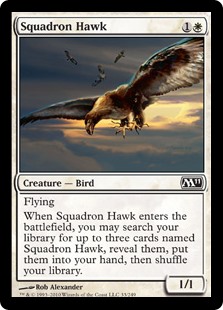 This was a lot of the problem with Cawblade nine years ago. There was very little variance between games, and from personal experience, the better player always won. The games took on the appearance of predestined outcomes, and while that's fine for a game like chess, it has proven to be very bad for Magic.
This was a lot of the problem with Cawblade nine years ago. There was very little variance between games, and from personal experience, the better player always won. The games took on the appearance of predestined outcomes, and while that's fine for a game like chess, it has proven to be very bad for Magic.
In hindsight, perhaps Wizards should have known that adding Commander elements to more competitive formats wouldn't work. Some of their reference points include the problems they've had with Brawl, but a survey of the Commander community would have also been instructive. At the last Magicfest I went to (remember when that was a thing? Good times) the Command Zone was divided by how competitive the decks were. There was a spectrum from wonky, weird, and wild decks that didn't really work all the way to singleton Vintage. From what I saw, the players were concentrated on the more casual side. I saw that at my LGS all the time pre-lockdown (good times). There were many Commander groups, but the more casual the group, the more regularly it met, and the larger it was.
Refinement Is Necessary
Wizards doesn't seem to have understood what made Commander so popular. They latched on to the most obvious superficial aspect with no understanding of the role it actually played. It's no wonder a direct port of its marquee mechanic to constructed has proven aggressively unpopular, and will have to either be banned or changed in the not-so-distant future.
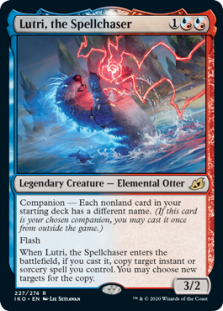 However, it doesn't have to be that way. Players like self-expression, which is a large part of what makes Commander great. Had the companions been made with that in mind, it may have been a success. Compare Lutri, the Spell Chaser to Yorion, Sky Nomad. The former requires considerable sacrifice, turning a consistent constructed deck into an inconsistent Commander deck. In return, there's a certainty boost. This makes Lutri a fun reward for outside-the-box deckbuilding and adds spice and variety to formats.
However, it doesn't have to be that way. Players like self-expression, which is a large part of what makes Commander great. Had the companions been made with that in mind, it may have been a success. Compare Lutri, the Spell Chaser to Yorion, Sky Nomad. The former requires considerable sacrifice, turning a consistent constructed deck into an inconsistent Commander deck. In return, there's a certainty boost. This makes Lutri a fun reward for outside-the-box deckbuilding and adds spice and variety to formats.
Yorion's requirement is too low, and so it boosts decks linearly. All the Arcum's Astrolabe decks have had to do is add more cantrip permanents and lands to their deck and convert their many 3-ofs to 4-ofs. In exchange, they get the certainty of not only a 4/5 flyer, but a mass flicker for more card advantage to make up for the slight consistency hit they took by playing 80 cards. That increased deck size has been found to be fun by some, but the power of Yorion has been too high. Had Wizards made more Lutris and fewer Yorions or Lurruses, I think companion may have been well received.
What to Expect
I'm with Jordan: talking about companion constantly is as boring as running into them every game. Next week, tune in for something unrelated I've been meaning to do for some time.



